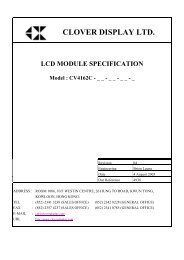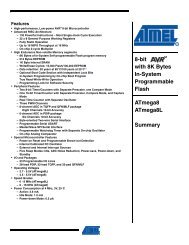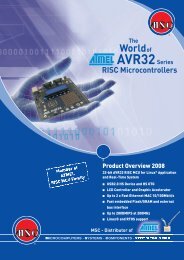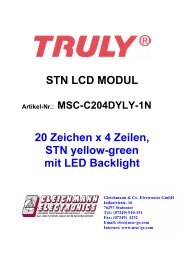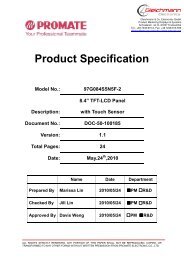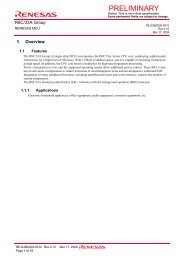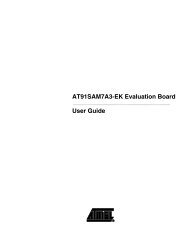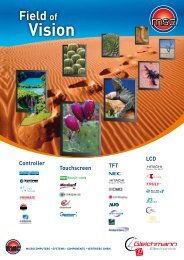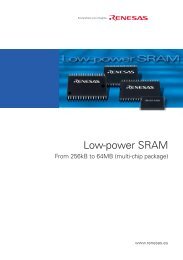SL811HS Embedded USB Host/Slave Controller
SL811HS Embedded USB Host/Slave Controller
SL811HS Embedded USB Host/Slave Controller
You also want an ePaper? Increase the reach of your titles
YUMPU automatically turns print PDFs into web optimized ePapers that Google loves.
<strong>SL811HS</strong><br />
48/28-Pin <strong>USB</strong> <strong>Host</strong> <strong>Controller</strong> Pins Description<br />
The <strong>SL811HS</strong>T-AXC is packaged in a 48-pin TQFP. The <strong>SL811HS</strong> and <strong>SL811HS</strong>-JCT packages are 28-pin PLCC’s. These<br />
devices require a 3.3 VDC power source. The 48-Pin TQFP requires an external 12 or 48 MHz crystal or clock.<br />
Table 35.<br />
48-Pin TQFP<br />
AXC Pin No.<br />
48/28-Pin TQFP AXC Pin Assignments and Definitions<br />
28-Pin PLCC<br />
Pin No.<br />
Pin Type Pin Name Pin Description<br />
1 – NC NC No connection.<br />
2 – NC NC No connection.<br />
3 5 IN nWR Write Strobe Input. An active LOW input used with nCS to write<br />
to registers/data memory.<br />
4 6 IN nCS Active LOW 48-Pin TQFP Chip select. Used with nRD and nWr<br />
when accessing the 48-Pin TQFP.<br />
5 [5] 7 [6] IN CM Clock Multiply. Select 12 MHz/48 MHz Clock Source.<br />
6 8 VDD1 +3.3 VDC Power for <strong>USB</strong> Transceivers. V DD1 may be connected to V DD .<br />
7 9 BIDIR DATA + <strong>USB</strong> Differential Data Signal HIGH Side.<br />
8 10 BIDIR DATA - <strong>USB</strong> Differential Data Signal LOW Side.<br />
9 11 GND <strong>USB</strong> GND Ground Connection for <strong>USB</strong>.<br />
10 – NC NC No connection.<br />
11 – NC NC No connection.<br />
12 – NC NC No connection.<br />
13 – NC NC No connection.<br />
14 – NC NC No connection.<br />
15 [7] 12 VDD +3.3 VDC Device V DD Power.<br />
16 13 IN CLK/X1 Clock or External Crystal X1 connection. The X1/X2 Clock<br />
requires external 12 or 48 MHz matching crystal or clock source.<br />
17 14 OUT X2 External Crystal X2 connection.<br />
18 15 IN nRST Device active low reset input.<br />
19 16 OUT INTRQ Active HIGH Interrupt Request output to external controller.<br />
20 17 GND GND Device Ground.<br />
21 18 BIDIR D0 Data 0. Microprocessor Data/Address Bus.<br />
22 – NC NC No connection.<br />
23 – NC NC No connection.<br />
24 – NC NC No connection.<br />
25 – NC NC No connection.<br />
26 – NC NC No connection.<br />
27 19 BIDIR D1 Data 1. Microprocessor Data/Address Bus.<br />
28 20 BIDIR D2 Data 2. Microprocessor Data/Address Bus.<br />
29 21 BIDIR D3 Data 3. Microprocessor Data/Address Bus.<br />
30 22 GND GND Device Ground.<br />
31 23 BIDIR D4 Data 4. Microprocessor Data/Address Bus.<br />
32 24 BIDIR D5 Data 5. Microprocessor Data/Address Bus.<br />
Notes<br />
5. The CM Clock Multiplier pin must be tied HIGH for a 12 MHz clock source and tied to ground for a 48 MHz clock source.<br />
6. The CM Clock Multiplier pin must be tied HIGH for a 12 MHz clock source and tied to ground for a 48 MHz clock source. In 28-pin PLCC’s, this pin is designated<br />
as an ALE input pin.<br />
7. VDD can be derived from the <strong>USB</strong> supply. See Figure 5 on page 19.<br />
Document 38-08008 Rev. *D Page 21 of 32<br />
[+] Feedback



